Guard Mounting
Guard Mounting, or Changing the Guard, refers to a formal ceremony in which sentries providing ceremonial guard duties at important institutions are relieved by a new batch of sentries. The ceremonies are often elaborate and precisely choreographed. They originated with peacetime and battlefield military drills introduced to enhance unit cohesion and effectiveness in the 17th century.
Canada

The changing the guard ceremony conducted in Canada is performed daily during the summer months at Rideau Hall, Parliament Hill and the National War Memorial in Ottawa by the combined Ceremonial Unit made up of the two Canadian regiments of Foot Guards. There is also a ceremonial Changing the Guard ceremony during the summer at the Citadelle of Quebec by members of the Royal 22e Régiment.[1]
Chile
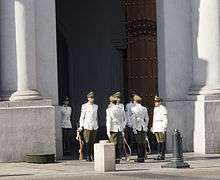
The changing of the guard ceremony is conducted every odd-numbered day, including Sundays, at La Moneda Palace in Santiago, Chile with the Carabineros de Chile's Presidential Guard Group providing the guard. A pair of mounted units lead the Central Band, Drums and Bugles of the Carabineros and the new guard to the plaza in front of La Moneda where the departing detachment meets them. While patriotic and popular music is played, the color guard emerges and salutes are exchanged between the old and new guards at the main gate and the officers of each unit. The ceremony ends with the band, drums and bugles marching off with the old guard.
Cuba
Soldiers of the Cuban Revolutionary Army guard the Mausoleum of José Marti in Santiago de Cuba. The guard is changed every half-hour, and is signaled by clock tower bells similar to how Soviet guards at the Lenin mausoleum used the bells of the Spasskaya Tower Clock.
Czech Republic
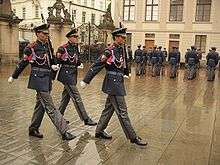
Every day at noon the guard of Prague Castle (seat of the President of the Czech Republic) is changed.
Denmark

At Amalienborg Palace, the royal residence in Copenhagen, the Royal Guard, mounted by the Kongelige Livgarde is on duty for 24 hours, and the relief takes place every day at 12 o'clock noon. The parade starts off from the barracks by Rosenborg Castle.
There are three types of guard changes:
- Kongevagt (King's Watch) - when the monarch is in residence - accompanied by the Royal Guards music band.
- Løjtnantsvagt (Lieutenant Watch) - when Prince Henrik is residing at the palace or Crown Prince Frederik or Prince Joachim are residing at Amalienborg in the capacity of regents - accompanied by the Corps of Drums of the RLG.
- Palævagt (Manor Watch) - the Crown Prince or Prince Joachim are in residence but not in the capacity of regents or the Palace is uninhabited - the Guards march through Copenhagen without music accompaniment.
Greece
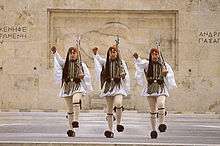
In the state capital, Athens, members of the elite Evzones light infantry unit, provide a 24-hour honor guard, with an hourly guard change, at the Presidential Mansion and at the Tomb of the Unknown Soldier, off Syntagma Square at the foot of the Hellenic Parliament. The Changing the Guard at the Tomb of the Unknown Soldier in particular has become a tourist attraction, with many people marvelling at the guards, who stand motionless for two 20-minute intervals, during their 1-hour shifts.
Every Sunday at 11:00 a ceremonial change of guards takes place. A parade of Evzones and a military band starts from the camp of the Evzones (just behind the Parliament Building) and through Vasilissis Sofias Avenue, reaches the Tomb of the Unknown soldier where a ceremonial change of guards takes place. On this occasion all the three official uniforms of the Evzones can be seen. For the needs of the ceremonial change of guard, Vasilissis Sofias Avenue and Amalias Avenue are briefly closed to traffic from approximately 10:55 to 11:05 on Sunday mornings.
Indonesia
Since the leadership of president Joko Widodo, the changing of the guard ceremony at Merdeka Palace done by the elite presidential force of Indonesia known as Paspampres has been opened to the public since 17 July 2016, then held every Sunday of the second week of each month in front of the palace yard, and now held at the last Sunday of the month starting 28 August the same year. The ceremony commences at 7am and is easily accessible for public and tourist viewing. Group A of Paspampres, which guards the president and the palace, is responsible for this ceremony.
India
A ceremonial changing of the guard is held at the President of India's official place of residence the Rashtrapati Bhavan. The ceremony is generally held every Saturday at 08.00 am (Summer), 10.00am (Winter). The old and new guard consists of a troop from the President's Body Guard (PBG) and another platoon drawn from one of the numerous regiments of the Indian Army. A military band is also present to provide accompaniment.
When the New Guard is formed up between the Dominion columns of the North Block, sentries are nominated and the respective guards are inspected by their officers as the band plays 'Sammaan Guard' (The Honour Guard). The men of the President's Bodyguard consist of the old warrior classes of the Rajputs, Sikhs and the Jats. Recruitment standards are strict and the minimum height of each soldier is six feet.
After the inspection is over, a formal march takes place into the forecourt of the Rashtrapati Bhavan with the band playing "Sher-E-Jawan" (Tiger of a soldier), The New Guard forms up along with the Old Guard to await the formal order of "Salami Shastra" (Present Arms) by the latter to the former, signifying readiness for the change-over. Accompanied by the tune "Robinson", the handing over of a key takes place between the Junior Commissioned Officer of the Old and New Guard. This symbolizes the exchange of responsibilities between commanders.
Sentries of the Old Guard rejoin and the Junior Commissioned Officers return to their posts. The Old Guard marches off to the tune "Saare Jahan Se Achcha" (Better than any nation). Compliments are paid by the New Guard which has assumed charge and the balance of the New Guard marches off along with the band playing "Amar Jawan" (Immortal Soldier).
See also Beating Retreat#India.
Italy
On the occasions of the Festival of the Tricolour on January 7, the anniversary of the Unification of Italy on March 14 and the Italian Republic Day on June 2, the Changing of the Guard at the Quirinal Palace is performed in its solemn form by the Corazzieri Regiment and by the mounted band of the Carabinieri 4th Cavalry Regiment, with the guards wearing their ceremonial dress uniforms and riding horses.
Every other day the Changing of the Guard takes place at the same hour, 18:00 during the summer and 16:00 for the rest of the year, and involves a military band from every service branch of the Italian Armed Forces and/or the State Police and other services (Vigili del Fuoco, Foresty Corps and Prisons Police) only if the President is in the Palace. The incoming unit marches into the internal courtyard in front of the outgoing unit, which presents arms and later again with the new guard to the tune of Il Canto degli Italiani. Then the sentinels of the outgoing unit surrender their posts to the sentinels of the incoming unit, and then the incoming unit presents arms as the outgoing unit marches out with an NCO or Warrant officer leading the old and new guard sentinels.
Similar protocols are followed every hour by the honor guards stationed at the gates of the seats of the Chamber of Deputies and the Senate, at the tomb of the unknown soldier at the Altare della Patria, and at the gates of the Quirinal Palace. In these cases a sub-officer leads the incoming unit in front of the standing guards, and leads the outgoing unit after they have surrendered their posts. Units forming for the regular mounting in various parts of Rome come from, aside from servicemen from the Carabineri, various units of the Italian Army, Navy, Air Force and the Financial Guard, and even the Italian State Police, and their respective bands provide the musical accompaniment to the Quirinal Palace ceremony.
Malaysia
The Changing the Guard takes place in front of the Istana Negara, Jalan Duta in Kuala Lumpur daily at 12 o'clock with the 1st Battalion, Royal Malay Regiment of the Malaysian Army providing the guard alongside the Mounted Ceremonial Squadron of the Malaysian Royal Armoured Corps.
Monaco
The Changing the Guard takes place in front of the Prince's Palace daily at 11:55, by the Compagnie des Carabiniers du Prince.[2]
Norway
In the state capitol, Oslo, His Majesty the King's Guard keeps The Royal Palace and the Royal Family guarded for 24 hours a day. Every day at 1330 hrs, there is a Change of Guards outside the Palace, and the ceremony itself, which consists of two parts, lasts for approximately 40 minutes. Otherwise, the guards work in shift of two hours. The Guards are also stationed at Akershus Fortress, where the Change of Guards also happens at 1330 hrs. They are also guarding the residence of the Crown Prince and Crown Princess, and their own camp, Gardeleiren, outside Oslo. The two latter duties are considered "green watches", where the guards wear battle uniform, an olive and green uniform featuring a short jacket, shirt and tie and the guard's unique forage cap. The famous parade uniform dating from 1860, which consists of a wide brimmed hat with black plume, dark blue tunic and trousers with white stripes, is worn on the more prestigious palace and fortress watches. Usually, during the summertime, there are Guard Parades, where the New Guard marches from Akershus Fortress accompanied by a band, through Oslo's parade street to Karl Johan’s Gate.
His Majesty the King's Guard is organized as a battalion, with a Lieutenant Colonel as chief. The battalion has 6 companies. Each company consists of approximately 200 guards, and has its own field of specialization.
- The 1st Company is a rifle company.
- The 2nd Company is a rifle company.
- The 3rd Company is a music and drill company only, and does actually not guard anything, due to the many arrangements and long training periods they have to attend.
- The 4th Company is a rifle company.
- The 5th Company is a staff and support company which has many important duties, such as transport and medical service inside the guard's camp.
- The 6th Company is the Guards recruit school.
- The 7th Company is the Guards Officer Candidate School.
His Majesty the King's Guard consists of male conscripts who are undertaking their compulsory military service, but also includes women who volunteer to join the Guards.
Portugal
The National Republican Guard (GNR) carries out a Changing the Guard (Portuguese: Render da Guarda) ceremony at the Belém Palace, official residence of the Portuguese President, on the third Sunday of each month at 11:00 am. The ceremony includes a performance by the cavalry musicians of the GNR's "Charanga a Cavalo", which claims to be the only mounted band in the world which performs at the gallop.
Romania
In Alba Iulia,at the citadel,the Guard is changed on Saturday and Sunday,at 12:00.This particular Guard unit is notable for its 18th century uniform, derived from the Habsburg Monarchy and complete with musket and wig.
Russia/USSR
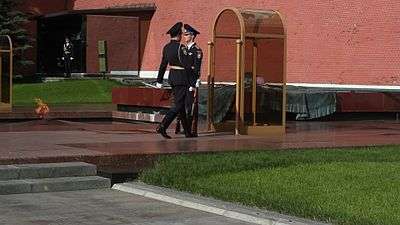

The Kremlin Regiment (Kremlyovskiy polk) of the Federal Protective Service provides the guard at the Tomb of the Unknown soldier in Moscow. During the day the guard is changed every hour. During the Soviet period the ceremony was carried out by what was then a KGB guard detachment at the Lenin Mausoleum. However, by decree of President of the Russian Federation Boris Yeltsin the guard has now been relocated to the Tomb of the Unknown Soldier in the gardens of the Kremlin.
Since the summer of 2016 another guard mount ceremony is held daily from the iconic Spasskaya Tower.
Republic of China (Taiwan)
In the Republic of China (Taiwan), the changing of the guard ceremony is conducted at three locations in Taipei, namely the National Chiang Kai-shek Memorial Hall, the Sun Yat-sen Memorial Hall, and the National Martyrs' Shrine, where the ceremonial guards are rotated by the hour during the opening hours of the three memorials. Servicemen from the honor guard detachments of the Republic of China Armed Forces provide the guard details in these locations alternating each day.
San Marino
The Guardia di Rocca conduct a Changing the Guard ceremony at the Palazzo Pubblico from April to September every half-hour from 8:30am to 6:30pm.[3]
Singapore

In Singapore, the ceremony is performed at the main entrance of the Istana, the official residence of the President of Singapore. Held on the first Sunday of each month, the ceremony begins just behind The Heeren, a shopping mall at Orchard Road, where military policemen from the Silent Precision Drill Squad of the Singapore Armed Forces Military Police Command (SAFMPC) leads the contingent of new guards (also from the SAFMPC) in a march down the road towards the Istana, with the Singapore Armed Forces Bands providing music and beats.
Upon arrival at the gates of the Istana, the actual change of guard ceremony takes place, after which the SPDS performs their precision drill routines with the accompaniment of music provided by the band. The old guard then marches off together with the band to Handy Road, where the entire procedure ends.
The COG was first performed by men from the Singapore Armed Forces Guards Unit before the responsibility was handed over to the SAFMPC on 4 May 1980. The Silent Precision Drill Squad was added to the ceremony in 1987.
The COG begins at 6 pm. The new guards begin their march at 5.45 pm, and the old guards end their march by around 6.30 pm.
South Korea

In South Korea, re-enactments of Guard changing ceremonies are held daily except on Tuesdays, at Deoksugung palace and Gyeongbokgung palace. It is a re-enactment of a traditional Guard changing ceremony, which was observed during the Joseon Dynasty.
The unit providing the guard is from the Traditional Guard Unit of the Republic of Korea Army.
Spain
In Spain there is a guard mounting ceremony at the Royal Palace of Madrid every Wednesday from 12 midday to 2pm (except July, August and September), weather permitting, as long as it does not coincide with another official event.[4]
The unit mounting the guard is provided by the Spanish Royal Guard.
Aside from this, the 1st King's Immemorial Infantry Regiment of AHQ does Guard Mounting Ceremonies on weekdays at noon at the Buenavista Palace in Madrid, the headquarters of the Spanish Army, and is also open to the public. The unit providing the guard is the regiment's Honor Guard Battalion, accompanied by the Regimental Band and the Corps of Drums, and its done per the military regulations of King Charles III and their respective drum and fife calls. The Honor Battalion's Fusilier and Grenadier companies wear the late 18th century regulation uniforms and carry period muskets from that era, and the drill is from those same regulations mentioned above.
Sri Lanka
The Changing the Guard at the President’s House occurs daily, conducted by the President’s Ceremonial Guard Company of the Sri Lanka Corps of Military Police, while other services of the Sri Lankan Armed Forces perform occasional mounting duties.
Sweden

The Changing the Guard at Stockholm Palace (Swedish: Kungliga Slottet), the official residence of the King and Queen of Sweden, occurs daily in its Outer courtyard. The Royal Guard unit of the Life Guards Regiment provide the guard unit for most of the year, while other services of the Swedish Armed Forces perform occasional mounting duties as may be requested.
Turkey
A Changing of the Guard ceremony takes place at Anıtkabir in Ankara. Anıtkabir contains the tomb of Mustafa Kemal Atatürk, the founder of modern Turkey.
United Kingdom

- See the article Changing of the Queen's Guard.
- See also the articles Beating Retreat and Trooping the Colour.
United States

A permanent guard is mounted at the Tomb of the Unknown Soldier at Arlington National Cemetery in Arlington, Virginia, near Washington, D. C. This is performed by a single member of the 3rd U.S. Infantry Regiment. There is a meticulous routine which the Tomb Guard follows during a 63 feet (19.2 m) march when watching over the Tomb.[5] The Guard:
- Marches 21 steps down the black mat behind the Tomb.
- Turns, faces east for 21 seconds.
- Turns and faces north for 21 seconds.
- Takes 21 steps down the mat.
- Repeats the routine until the soldier is relieved of duty at the Changing of the Guard.
After each turn, the Guard executes a sharp "shoulder-arms" movement to place his or her M14 rifle on the shoulder closest to the visitors to signify that the Guard stands between the Tomb and any possible threat. Twenty-one was chosen because it symbolizes the highest military honor that can be bestowed—the 21-gun salute.
Each turn the guard makes is precise and is instantly followed by a loud click of the heels as he snaps them together. A guard has been on duty at the site continuously, 24 hours a day, 7 days a week, since July 2, 1937. The watch has been maintained even in cases of inclement weather or terrorist attack.
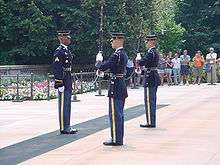

During the day in summer months from April 1 to September 30, the guard is changed every half-hour. During the winter months, from October 1 to March 31, the guard is changed every hour. After the cemetery closes to the public (7 p.m. to 8 a.m. April through September, and 5 p.m. to 8 a.m. October through March), the guard is changed every 2 hours. The ceremony can be witnessed by the public whenever Arlington National Cemetery is open.[6][7]
The guard change is very symbolic, but also conducted in accordance with Army regulations. The relief commander or assistant relief commander, along with the oncoming guard, are both required for a guard change to take place. The relief commander orders the guard being relieved to "pass on your orders" to the oncoming guard. The guard being relieved will say to the oncoming guard, "Post and orders, remain as directed." The oncoming guard's response is always, "Orders acknowledged." During changes when the public is witnessing the ceremony, the commander will inform the public that the ceremony is about to take place and that those in attendance should remain "silent and standing" throughout the entire event.
While the guards are all members of the United States Army, the soldier "walking the mat" does not wear his or her rank insignia, so as not to outrank the Unknowns, whatever their ranks may have been. Non-commissioned officers (usually the Relief Commander and Assistant Relief Commanders), do wear the insignia of their rank when changing the guard only. They have a separate uniform (without rank) that is worn when they actually guard the Unknowns or are "Posted".
Vietnam
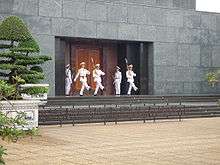
The Changing of the Guards in Hanoi Vietnam takes place at the Ho Chi Minh Mausoleum which is guarded by the Honor guard of the Ministry of Defense of Vietnam. The mausoleum contains the preserved body of Ho Chi Minh.
References
- ↑ Archived July 21, 2009, at the Wayback Machine.
- ↑ Archived November 13, 2011, at the Wayback Machine.
- ↑ Chiappini, Vinnie; et al. (2007). Let's Go Italy. MacMillian. p. 420.
- ↑ Archived February 19, 2013, at the Wayback Machine.
- ↑ "The Changing of the Guard". Arlington, Virginia: Arlington National Cemetery. Archived from the original on 2013-01-21. Retrieved 2013-01-21.
- ↑ "Frequently Asked Questions". Society of the Honor Guard – Tomb of the Unknown Soldier. Retrieved 2007-09-23.
- ↑ "Visiting Arlington National Cemetery". Arlington National Cemetery. Retrieved 2007-09-23.
External links
| Look up changing the guard in Wiktionary, the free dictionary. |
| Wikimedia Commons has media related to Changing the Guard. |
- The British Monarchy's page on the subject
- British schedule of regiments and dates
- Changing the Guard in Ottawa
- Guarding the Tomb of the Unknown Soldier at Arlington Cemetery
- Changing the Guard at Rashtrapati Bhavan, India
- Solemn Changing of the Guard at the Quirinal Palace during the Festival of the Tricolour